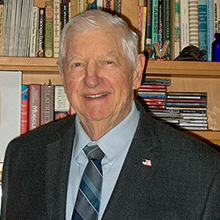Featured Member
Anthony W. Kotula, Ph.D.

January Emeritus Spotlight
Q: Where are you residing today?
A: Mansfield, CT
Q: Why did you decide to pursue a career in meat science?
A: When I graduated from the University of Massachusetts with a B.S. in chemistry, I entered the United States Air Force for my two years of active duty. During my last year, during the Korean War, I was stationed at Kimpo Air Base, where I was the Supply Officer, First Lieutenant of the 15th Tactical Reconnaissance Squadron.
When I returned from Korea and was honorably separated, I went back to the University of Massachusetts for a graduate degree using the G.I. Bill. Dr. Carl R. Fellers, Chair of the Food Science Department, accepted me for an M.S. in Food Science. Upon graduation, Dr. Fellers arranged for me to obtain a research position at the Agricultural Marketing Service, USDA in Washington D.C., to improve the quality and wholesomeness of poultry. After about 2 years, our group was transferred to the Beltsville Agricultural Research Center in Maryland. The time in Washington D.C. allowed me to find my future wife, Joan D. Ryziewicz, a secretary in the financial section of the Secretary of Agriculture.
Q: Who was your mentor when you first started?
A: Dr. Lyle Davis was my first boss in AMS. He had a curiosity about gamma irradiation of poultry, carbon dioxide immobilization of poultry, poultry air sac contamination, determining water uptake of poultry by chilling methods, microbiological controls, and other aspects. This dovetailed well with my interests.
Q: When, why and how did you become involved in AMSA?
A: During my first twelve years with the USDA, my research involved research with the poultry industry. Joan, my wife, suggested I seek a modified work schedule to obtain a Ph.D. at the University of Maryland which was only seven miles from Beltsville. After two years, my modified work schedule was approved with the agreement that if my research decreased, I would stop my studies regardless of how close to completion I had progressed.
When I received my Ph.D. in 1965, I was called by the upper echelons and told to start a new laboratory. I was instructed to close the existing two meat laboratories and take the staff into the new laboratory, “The Meat Science Research Laboratory”. I was told my responsibility was to spend 86% of my time managing the laboratory and to continue to produce at least three research projects each year. I joined the AMSA right away.
Since retirement in 1992, I have been an Emeritus Member of AMSA. Membership in AMSA is extremely important to me because of the wonderful, interesting, and knowledgeable people in the association and the exchange of ideas.
Q: What do you consider to be your greatest contribution to meat science to date?
A: The ability to choose research to assist the Food Safety and Inspection Service, the Agricultural Marketing Service, the Natick Army Research and Development Command, the FDA, scientists at universities in and out of the United States, and the meat and poultry industries.
Q: What's your fondest memory of an RMC you attended? Which was your first RMC? How many RMCs did you attend?
A: My first RMC was probably 1965. I attended most of the RMCs until I retired and a few afterward. My fondest memories of the RMCs I attended were the science presented and the interaction with scientists.
Q: What is your biggest piece of advice to those building their career?
A: Use sound research and publications to make decisions. Perform research that has Impact – significant practical and meaningful applications that solve vexing problems of the meat/food industry.
Q: What do you miss the most since you have retired?
A: I still have research ideas but lack the funding and facility to do this research to improve the wholesomeness of poultry, meat and eggs. I continue to reach out to active researchers to share these ideas.
I still interact with some AMSA members but miss the more day-to-day interactions and scientific cooperation.
I miss Joan, my wife, who died in 2014 after 57 years, 6 months, and 4 days of marriage. We enjoyed our children and grandchildren.
Q: What are your current hobbies? How do you fill you day?
A: I am seeking funding to support research to develop a vaccine against Toxoplasma gondii in cats and mice, and a decrease of toxoplasmosis in our population.
We live two miles from the University of Connecticut but have deer, wild turkeys, and songbirds visit our farm. We occasionally see a bobcat, fox, or hawk seeking to eat one of our chickens. Our chickens are well protected in their fenced yard next to their house. Presently we are grafting our fruit trees and some additional fruit trees to have the trees grow only to 12 feet high. Our other fruit trees are quite tall.
Q: If you could plan a vacation to anywhere in the world, where would you go?
A: Since I enjoy this small farm and have traveled extensively already, I’m happy at home – particularly to watch the chickens and wildlife and see the trees and plants grow and produce.